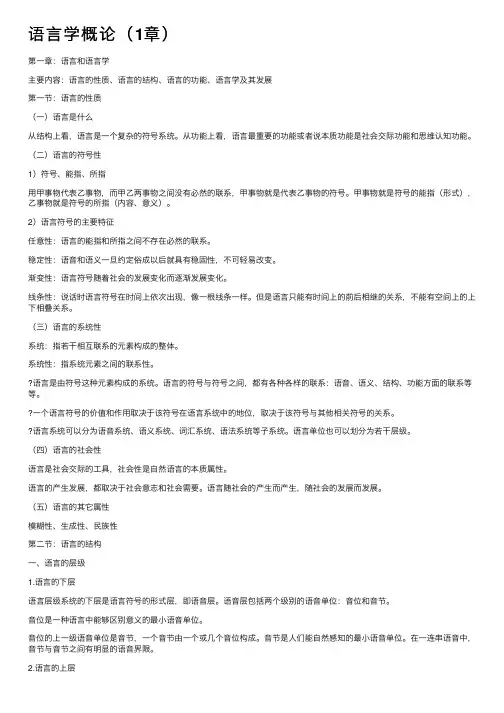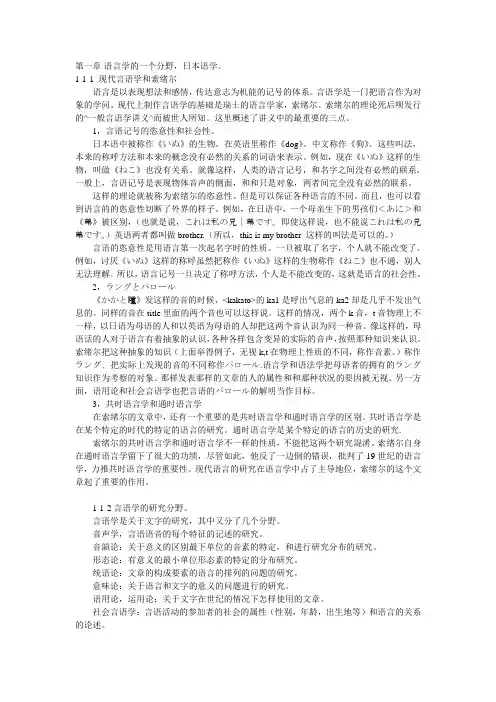语言学第一章
语言学概论 第一章

2、人们平时常说,“无产阶级和资产阶级没有共同语 言”,“工人有工人的语言,农民有农民的语言”。 这是不是说,语言具有阶级性? 语言没有阶级性。第一,语言是社会全体成员共同的 交际工具,全体成员,包括各个阶级、阶层的人,不 分男女,不分老幼,无论什么人,与别人交际都要使 用语言。如果语言有阶级性,不同阶级的人说不同的 话,那么阶级之间就无法进行交际(不同阶级之间的 斗争,也就是一种交际活动)。第二,语言结构本身, 没有阶级可言,比如语音、语法规则,就谈不上有阶 级性。第三,语言是伴随着人类同时出现的,而在人 类从猿到人这个漫长的过程中,根本就没有阶级的区 分,所以从语言的诞生过程看,语言也是没有阶级性 的。
二、考察语言同思维关系的途径: 1、儿童学习语言的过程: (1)咿呀期 (2)单词句阶段 (3)双词句阶段 (4)电报句阶段 (5)接近成人阶段
2、神经生理学的实验: (1)病理实验 (2)解剖实验 (3)刺激----反应实验: 左耳——语言——直接、准确、敏捷 右耳——非语言信息——直接、准确、敏捷
三、语言是人类的交际工具: ★身势,面部表情等伴随动作 ★旗语 ★信号弹 ★红绿灯 ★电报代码 ★化学公式之类符号 ★文字 ★语言 伴随动作一般都是在语言的基础上产生的,而且伴随 伴随动作 语言交际一起发生;旗语之类 旗语之类是建立在语言、文字基 旗语之类 础上的辅助性交际工具,它们的服务领域相当狭窄; 文字是建立在语言基础之上的一种最重要的辅助交际 文字 工具;只有语言 语言才是人类最重要的交际工具。 语言
3、两个人在争论语言和思维的关系,一个人说先有语言,因为 语言是思维工具,没有这个工具就无法思维;一个人说先有思 维,因为语句是思维的成果,没有思维,人们无法把散沙一样 的词语组合成句。你认为谁的观点对呢? 两个人的话看似有理,但由于割裂了语言与思维的关系,所以 都是无理的,都是片面的。首先,语言和思维是互相依存的, 各以对方为存在的条件;语言是思维的工具,语言离不开思维, 思维也不能脱离语言;如果没有思维,没有思想,人际之间的 交流,无从谈起,语言的存在也失去了任何意义。其次,语言 和思维的发展程度是相互适应的,是一致的;有什么样的思维 水平,就有什么样的语言水平,有什么样的语言水平,就有什 么样的思维水平,不可能一个社会发展到语言和思维脱节的地 步,语言水平很高且思维水平很低,或思维水平很高而语言水 平很低,这都是不可想象的,也是不可能的。 •
语言学概论(第一章)

比语言来得更好。言为心声,语言的表达效果离不开使用者、使 用环境等。
二、语言的思维功能
语言和思维的关系 1.什么是思维
形象思维---抽象思维 苹果的例子
2.其他学科对思维的研究
无论是传统的哲学、逻辑学对思维的研究,还是现代科学对思维 的探索,语言都始终是不可或缺的要素。
语言是思维活动的动因和载体,是思维成果的贮存所。语言和思 维密不可分,语言的思维功能是语言的基本属性。
汉语:红、橙、黄、绿、青、蓝、紫 英语:purple, blue, green, yellow, orange, red 汉语:伯父、叔父、姑父、姨夫;伯母、叔母、姑母、姨母 英语:uncle, aunt 汉语:一本书、三个人、两支笔 英语:one book, three p话语、实词句、成人句
3.儿童语言习得途径论
克拉申的输入假设、斯万的输出假设
4.儿童语言习得关键期论
支持关键期假说的研究、反对关键期假说的研究
二、语言的思维功能
关于聋哑人的语言和思维 1.聋哑人和常人一样,生活在人类社会中,有健全的大脑
和发音器官,他们的大脑也分左右两半球,各有各的分工。 2.大脑是人的一切活动的司令部,人的各种感觉器官由它统
语言学概论
An Introduction to Linguistics
第一章 语言的功能
第一章 语言的功能
每一语言里都包含着一种独特的世界观。 ---洪堡特
一、语言的社会功能
语言的信息传递功能 1.人类社会中语言信息传递的作用
维系社会成员之间的联系 分工协作 彼此分享经验感受 文化传承
2.人类社会信息传递的其他方式及其与语言的关联
2.儿童语言习得和思维发展的关系
语言学第一章

语言学第一章Chapter 1 Invitation to linguistics1.1 Why study language?1. Language is very essential to human beings.2. In language there are many things we should know.3. For further understanding, we need to study language scientifically.1.2 What is language?Language is a means of verbal communication. It is a system of arbitrary vocal symbols used for human communication.1.3 Design features of languageThe features that define our human languages can be called design features which can distinguish human language from any animal system of communication.1.3.1 ArbitrarinessArbitrariness refers to the fact that the forms of linguistic signs bear no natural relationship to their meanings.1.3.2 DualityDuality refers to the property of having two levels of structures, such that units of the primary level are composed of elements of the secondary level and each of the two levels has its own principles of organization.1.3.3 CreativityCreativity means that language is resourceful because of its duality and its recursiveness.Recursiveness refers to the rule which can be applied repeatedly without any definite limit. The recursive nature of language provides a theoretical basis for the possibility of creating endless sentences.1.3.4 DisplacementDisplacement means that human languages enable their users to symbolize objects, events and concepts which are not present (in time and space) at the moment of conversation.1.4 Origin of language1. The bow-wow theoryIn primitive times people imitated the sounds of the animal calls in the wild environment they lived and speech developed from that.2. The pooh-pooh theoryIn the hard life of our primitive ancestors, they utter instinctive sounds of pains, anger and joy which gradually developed into language.3. The “yo-he-ho” theoryAs primitive people worked together, they produced some rhythmic grunts which gradually developed into chants and then into language.1.5 Functions of languageJacobson——language has six functions:1. Referential指称功能: to convey message and information;2. Poetic: to indulge in language for its own sake;3. Emotive: to express attitudes, feelings and emotions;4. Conative意动功能: to persuade and influence others through commands and entreaties;5. Phatic寒暄功能: to establish communion with others;6. Metalingual元语功能: to clear up intentions, words and meanings.Halliday ——that language has three metafunctions:1. Ideational function: to convey new information, to communicate a content that is unknown to thehearer;2. Interpersonal function: embodying all use of language to express social and personal relationships;3. Textual function: referring to the fact that language has mechanisms to make any stretch of spokenand written discourse into a coherent and unified text and make a living passage different from a random list of sentences.Hu Zhuanglin——language has at least seven functions:1.5.1 InformativeThe informative function means language is the instrument of thought and people often use it to communicate new information.1.5.2 Interpersonal functionThe interpersonal function means people can use language to establish and maintain their status in a society.1.5.3 Performative施为功能The performative function of language is primarily to change the social status of persons, as in marriage ceremonies, the sentencing of criminals, the blessing of children, the naming of a ship at a launching ceremony, and the cursing of enemies.1.5.4 Emotive functionThe emotive function is one of the most powerful uses of language because it is so crucial in changing the emotional status of an audience for or against someone or something.1.5.5 Phatic communionThe phatic communion means people always use some small, seemingly meaningless expressions such as Good morning, God bless you, Nice day,etc., to maintain a comfortable relationship between people without any factual content.1.5.6 Recreational functionThe recreational function means people use language for the sheer joy of using it, suc h as a baby’s babbling or a chanter’s chanting.1.5.7 Metalingual functionThe metalingual function means people can use language to talk about itself. E.g. I can use the word “book” to talk about a book, and I can also use the expression “the word book” t o talk about the sign “b-o-o-k” itself.1.6 What is linguistics?Linguistics is the scientific study of language. It studies not just one language of any one community, but the language of all human beings.1.7 Main branches of linguistics1.7.1 PhoneticsPhonetics is the study of speech sounds, it includes three main areas: articulatory phonetics, acoustic phonetics, and auditory phonetics.1.7.2 PhonologyPhonology studies the rules governing the structure, distribution, and sequencing of speech sounds and the shape of syllables.1.7.3 MorphologyMorphology studies the minimal units of meaning –morphemes and word-formation processes.1.7.4 SyntaxSyntax refers to the rules governing the way words are combined to form sentences in a language, or simply, the study of the formation of sentences.1.7.5 SemanticsSemantics examines how meaning is encoded in a language.1.7.6 PragmaticsPragmatics is the study of meaning in context.1.8 MacrolinguisticsMacrolinguistics is the study of language in all aspects, distinct from microlinguistics, which dealtsolely with the formal aspect of language system.1.8.1 Psycholinguistics心理语言学Psycholinguistics investigates the interrelation of language and mind, in processing and producing utterances (and in language acquisition for example).1.8.2 Sociolinguistics社会语言学Sociolinguistics is the study of the characteristics of language varieties1, the characteristics of their functions2, and the characteristics of their speakers3. (123相互作用构成一个speech community 语言社团)1.8.3 Anthropological linguistics人类语言学Anthropological linguistics studies the history and structure of formerly unwritten language, the emergence of language and the divergence of languages.1.8.4 Computational linguistics计算语言学Computational linguistics is an interdisciplinary field which centers around the use of computers to process or produce human language.1.9 Important distinctions in linguistics1.9.1 Descriptive描写vs. Prescriptive规定A linguistic study is descriptive if it describes and analyses the facts observed.It is prescriptive if it tries to lay down rules for the “correct” use of language.1.9.2 Synchronic共时vs. Diachronic历时The description of a language at some point in time is a synchronic study.The description of a language as it changes through the time is a diachronic study.The distinction between synchronic and dischronic studies is only theoretically clear.原因:①Languages are in a constant state of changing.②The language of any speech community is never uniform.③When a language changes, one set o f features are not suddenly replaced by another set of features.1.9.3 Langue 语言& parole言语Saussure distinguished the linguistic competence of the speaker and the actual phenomena or data of linguistics as langue and parole.Langue refers to the abstract linguistic system shared by all the members of a speech community.Parole refers to the actualized language, or realization of langue.区别:①Langue is abstract but parole is specific to the situation in which it occurs.②Langue is not actually spoken by anyone; parole is alwaysa naturally occurring event.③Langue is relatively stable and systematic; parole is subject to personal and situational constraints.1.9.4 Competence and performanceAccording to Chomsky, a language user’s underlying knowledge about the system of rules is called the linguistic competence, and the actual use of language in concretesituations is called performance.Competence is the ideal language user`s knowledge of the rules of his language.Performance is the actual realization of this knowledge in utterances.。
语言学概论(1章)

语⾔学概论(1章)第⼀章:语⾔和语⾔学主要内容:语⾔的性质、语⾔的结构、语⾔的功能、语⾔学及其发展第⼀节:语⾔的性质(⼀)语⾔是什么从结构上看,语⾔是⼀个复杂的符号系统。
从功能上看,语⾔最重要的功能或者说本质功能是社会交际功能和思维认知功能。
(⼆)语⾔的符号性1)符号、能指、所指⽤甲事物代表⼄事物,⽽甲⼄两事物之间没有必然的联系,甲事物就是代表⼄事物的符号。
甲事物就是符号的能指(形式),⼄事物就是符号的所指(内容、意义)。
2)语⾔符号的主要特征任意性:语⾔的能指和所指之间不存在必然的联系。
稳定性:语⾳和语义⼀旦约定俗成以后就具有稳固性,不可轻易改变。
渐变性:语⾔符号随着社会的发展变化⽽逐渐发展变化。
线条性:说话时语⾔符号在时间上依次出现,像⼀根线条⼀样。
但是语⾔只能有时间上的前后相继的关系,不能有空间上的上下相叠关系。
(三)语⾔的系统性系统:指若⼲相互联系的元素构成的整体。
系统性:指系统元素之间的联系性。
语⾔是由符号这种元素构成的系统。
语⾔的符号与符号之间,都有各种各样的联系:语⾳、语义、结构、功能⽅⾯的联系等等。
⼀个语⾔符号的价值和作⽤取决于该符号在语⾔系统中的地位,取决于该符号与其他相关符号的关系。
语⾔系统可以分为语⾳系统、语义系统、词汇系统、语法系统等⼦系统。
语⾔单位也可以划分为若⼲层级。
(四)语⾔的社会性语⾔是社会交际的⼯具,社会性是⾃然语⾔的本质属性。
语⾔的产⽣发展,都取决于社会意志和社会需要。
语⾔随社会的产⽣⽽产⽣,随社会的发展⽽发展。
(五)语⾔的其它属性模糊性、⽣成性、民族性第⼆节:语⾔的结构⼀、语⾔的层级1.语⾔的下层语⾔层级系统的下层是语⾔符号的形式层,即语⾳层。
语⾳层包括两个级别的语⾳单位:⾳位和⾳节。
⾳位是⼀种语⾔中能够区别意义的最⼩语⾳单位。
⾳位的上⼀级语⾳单位是⾳节,⼀个⾳节由⼀个或⼏个⾳位构成。
⾳节是⼈们能⾃然感知的最⼩语⾳单位。
在⼀连串语⾳中,⾳节与⾳节之间有明显的语⾳界限。
语言学概论第一章

第一章语言学的一个分野,日本语学。
1-1-1 现代言语学和索绪尔语言是以表现想法和感情,传达意志为机能的记号的体系。
言语学是一门把语言作为对象的学问。
现代上制作言语学的基础是瑞士的语言学家,索绪尔。
索绪尔的理论死后呗发行的^一般言语学讲义^而被世人所知。
这里概述了讲义中的最重要的三点。
1,言语记号的恣意性和社会性。
日本语中被称作《いぬ》的生物,在英语里称作《dog》。
中文称作《狗》。
这些叫法,本来的称呼方法和本来的概念没有必然的关系的词语来表示。
例如,现在《いぬ》这样的生物,叫做《ねこ》也没有关系。
就像这样,人类的语言记号,和名字之间没有必然的联系,一般上,言语记号是表现物体音声的侧面,和和只是对象,两者间完全没有必然的联系。
这样的理论就被称为索绪尔的恣意性。
但是可以保证各种语言的不同。
而且,也可以看到语言的的恣意性切断了外界的样子。
例如,在日语中,一个母亲生下的男孩们<あに>和《弟》被区别,(也就是说,これは私の兄|弟です。
即使这样说,也不能说これは私の兄弟です。
)英语两者都叫做brother.(所以,this is my brother 这样的叫法是可以的。
)言语的恣意性是用语言第一次起名字时的性质。
一旦被取了名字,个人就不能改变了。
例如,讨厌《いぬ》这样的称呼虽然把称作《いぬ》这样的生物称作《ねこ》也不通,别人无法理解。
所以,语言记号一旦决定了称呼方法,个人是不能改变的,这就是语言的社会性。
2,ラングとパロール《かかと踵》发这样的音的时候,<kakato>的ka1是呼出气息的ka2却是几乎不发出气息的。
同样的音在title里面的两个音也可以这样说。
这样的情况,两个k音,t音物理上不一样,以日语为母语的人和以英语为母语的人却把这两个音认识为同一种音。
像这样的,母语话的人对于语言有着抽象的认识,各种各样包含变异的实际的音声,按照那种知识来认识。
索绪尔把这种抽象的知识(上面举得例子,无视k,t在物理上性质的不同,称作音素。
语言学概论第1章语言

符号与征候不同(指的是发生某种情况的迹象) (1)符号的含义:符号就是由社会约定俗成的,由
一定的形式构成的表示一定意义的记号或标记, 其作用是指称现实现象。 (2)符号的构成:形式和内容
(3)符号的种类很多 视觉符号、听觉符号触觉符号
(3)语言符号的特点: a、任意性 b、线条性 C、稳定性 d、可变性、发展性 e、生成性 f、概括性、民族性、时代性
a、任意性(约定性、强制性)和二重性(两面性)
思考:为什么人类会有这样多形形色色的语言?
语言符号的任意性特点具体表现
语言符号的任意性特点具体表现:
第一,语言符号的音义的结合是任意性的,由社 会约定俗成的,即什么样的语音形式表达什么样 的意义内容,什么样的意义内容用什么样的语音 形式表现是任意的;
白花 红花 蓝花 紫花 大花 小花 好花
上层 底层
第三级 三级 第二级
第一级
句子 词 语素 音位
音义结合的符号 与符号的序列
性质上的飞跃; 数量上的飞跃
思考:
任何一种语言所包含的句子的数量都是无 限的,那么人类为什么能在有限的时间内掌握 语言呢?
第一、语言是一种层级结构,最底层的音 位(几十个)是很少的;第二、用语素(几千 个)组成的词(几万个)的数量也是有限的, 而且可以重复使用,这样就通过词的不同组合 创造出数量庞大的句子(无数个)来;第三、 更加重要的是词和词组合成为句子的规则也是 有限的。
B,为什么说组合关系、聚合关系是语言系统中两种最基本 的关系?请举例说明。
第一章 语言
(三)社会性——人类语言与动物语言的区别 (四)全民性——怎样理解语言没有阶级性 三、语言的功能 (一)交际职能:语言是人类最重要的交际工具 (二)思维职能 1、思维和思想不同 2、思维能力与思维方式不同 3、语言和思维的关系 4、语言和思维的区别
语言学概论 第一章
二、其他观点
• • • • •
2.资源论: 认为语言是一种资源。 《现代汉语词典》 《现代汉语规范词典》 对外汉语 英语 3.问题论: 把语言看成是一种问题 出发点就是要解决问题,这个国家有语言问题,就要解决语 言问题。在此基础上就有语言规划或计划问题。这出来后就被民 族主义者与政治家利用了。 • 4.权利论: 即天赋人权,天赋语1.载体论: • 认为语言是文化的载体、信息的载体 • (1)文化是人类社会知识的总和,是人类理解和叙述事物的模 式。 • 从外延上看,文化可以分为物质文化、智能文化、制度文化和 精神文化四种类型。 • (2)语言是文化的载体 • A 语言是文化的一部分。 • B 语言反映文化,或者说语言具有文化镜像功能。 • a 语言对文化的反映首先表现在言语作品的内容上。 • b 语言系统本身也记录和反映人类文化的面貌。 • c 通过语言还可以揭示没有被语言作品记录下来的文化。 • C 语言传承文化。
三、语言是一种特殊的社会现象
• 1.语言是一种社会现象 • (1)语言是社会的产物。 • (2)语言不是自然现象,它与自然现象有根本的区别。一方面, 语言的产生、发展等都要受到社会的制约。另一方面,语言的音 义联系是由社会约定俗成的,。 • (3)语言不是个人现象,与个人现象有区别。 • 2 .语言是一种特殊的社会现象 • 语言不是经济基础,也不是上层建筑。 • 经济基础是社会生产关系的总和,是社会发展一定阶段上的社会 经济制度。 • 上层建筑是社会上政治、法律、哲学等观点和相应的制度设施, 同一定历史时期的社会经济基础相适应,同人的生产行为没有直 接联系。
第一章 语言的社会功能
• • • • •
• • • • • • •
一、工具论 工具论认为,语言是人类最重要的交际工具 1.语言是人类的交际工具 2.语言是最重要的交际工具 3.语言是全民的交际工具。
语言学概论第一章
第一章:语言和语言学§1语言的客观存在形式1口语:语言的客观存在形式首先是有声的口头语言。
2书面语:文字出现以后,语的第二种客观存在形式。
3言语交际是一个编码和解码素:生活经历、社会环境、当前处理的问题、社会问化问题、哲学问题、逻辑问题。
人要接受语言所素:组织与分析的能力、心理、生理问题;发音、听音的器官和神经网络及机制和能力;复杂的生理和物理问题。
总之一句话,言语交际是通过许多因素对语言进行编码和解码的过程,言者编码,听者解码。
“码”即所谓的言语4书面语和口语的主要差别。
是那些口语所特有的面部表情、手势和体态,还有口气和语调用书面的文字语言来描述出来的成分,也就是书面语补上的某些省略以后影响理解的成分。
用二者的分析可以用公式理解:口语的基本语言成分=书面语的基本语言成分+用书面描写的口语非语言成分。
5书面语的产生具有重大的社会历史意义。
书面语克服了人和人之间进行交际、和交流思想感情在空间和时间方面的限制,极大地加快了人类社会经验和知识积累的速度和传播的范围,从而大大加快了社会发展的步伐。
6语言和种族的关系。
二者有必然的联系,根本原因是:语言能力和生理因素素有关,但是语言是一种社会现象,完全是在一定的语言环境中后天获得的,所以语言和种族没有必然联系。
7语言与各个领域的社会活动都有着密切的联系,在这种情况下,语言学必须明确自己的研究对象,才能成为一门现代化的,可以从各个不同的角度,根据不同的需要,去研究客观存在的语言的各个不同的方面。
门现代意义上的科学首先要有明确的研究对象,然后才有可能形成自己完整的理论体系和方法论体系,那样才能成为一门现代意义上的科果研究对象长期不确定确,或者研究对象太杂,范围太宽,研究就不可能深入,就不可能形成自己的理论体系和方法论体系。
8什么是语言的客观存在形式。
首先表现为人类社会中人与人之间的口头交际行们每个人从出生那一天起就始终生活在一定的社会群体中。
人类为了繁衍生息,为了共同进行劳动生产,为了保护个人和整个群体,就要相互合作,相互协调,这就需要互相传递信息,互相交流思想感情。
语言学(第一章)
• 2.“两线” • (1)上古时期的两线斗争 • 名实关系:名由人定(参差)-名实相应 (整齐) • (2)中古时期的两线斗争 • 重程式化形式(理论)-重实际用法(材 料) • (3)近古时期的两线斗争 • 普遍唯理语法(内部研究)-经验主义 (外部研究) • (4)现当代时期的两线斗争 • 谱系论-波浪说
• (二)语言学的意义
• • • • 1、语言学是一门领先学科 2、语言教学与研究离不开语言学 3、制定和理解语文政策需要语言学 4、指导语言运用和文学创作、欣赏、研究 和翻译
第二节 语言和言语的对立统一
• 一、语言和言语的定义 • 言语就是个人讲话(写作)的行为和结果;语言是 人们所说(写)和存在于所说(所写)中的音义结 合的词汇系统和语法系统。 • 二、语言和言语的关系 • (一)二者的区别 • 1、语言是稳定的,具有相对静止状态;言语是自由 结合的,具有运动状态。 • 2、语言是社会共有的交际工具;言语除了社会因素 外,还具有个人因素。 • 3、语言系统的各个结构成分是有限的,但可以用它 们说出无限多的句子来。
• ห้องสมุดไป่ตู้ • • • •
(二)二者的联系 1、言语是第一性的,语言是第二性的。 2、语言来源于言语,又反作用于言语。 三、区分语言和言语的意义 1、明确了语言研究的不同领域。 2、为语言的学习和研究提供了一个模式: 言语-语言-言语
第三节 语言的社会功能
• • • • 一、语言是人类独有的最重要的交际工具 (一)语言是交际工具 交际功能是语言最根本的功能 (二)语言是最重要的交际工具
• • • •
(三)语言的混合和融合 1. 语言的混合 克里奥耳语、“洋泾浜”语。 2. 语言的融合
• 一种语言战胜了另一种语言或一种语言被 另一种语言吞噬的现象,叫做语言的融合。 • 语言的融合有自愿融合与被迫融合两种。 历史上鲜卑族的魏孝文帝所谓“断诸北语, 一从正音”的改革就是自愿融合,金朝的 女真语则是被迫融合。
语言学概论完整版
完整版<语言学概论> 第一章: 语言和语言学一识记内容1口语:语言的客观存在形式首先是有声的口头语言2书面语:文字出现后语言的第二种客观存在形式3符号:指的是根据社会的约定俗成使用某种特定的物质实体来表示某种特定的意义而形成的这种实体和意义的结合体4能指:语言符号的物质实体能够指称某种意义的成分5所指:也就是“能指成分”,即特定的物质实体,所指的意义内容6聚合关系:在同一个位置上可以互相替换出现的各个语言单位处在互相可以联想起来的关系之中,因而聚合成为一个类7组合关系:组合关系体现为一个语言单位和前一个语言单位或后一个语言单位,或和前后两个语言单位之间的关系,也体现了部分与整体之间的关系8语言学:是研究语言的科学9普通语言学:语言学界把研究人类社会的语言这种社会现象的一般理论10理论语言学:把研究某种具体语言的语言学称为汉语语言学或英语语言学等等,把侧重理论探讨的称为理论语言学11应用语言学:侧重语言学理论和成果的实际应用12传统语言学:一般泛指20世纪前的语言学,特别是指索绪尔开创的结构主义语言学以前的语言学13结构主义语言学:索绪尔创立的语言学可以称为“结构主义语言学”,至于我国内常说的“结构主义语言学”“结构主义语法”,往往只是指在国外影响较大并且我国语言学界比较熟悉的美国结构主义描写语言学,那只是当代结构主义语言学的一个流派,并不等于受索绪尔影响的整个结构主义语言学二领会内容不用识记,大体知道即可1言语交际是一个编码和解码的过程?答:人要说话所需要的因素:生活经历社会环境当前处理的问题社会问题文化问题哲学问题逻辑问题人要接受语言所需要的因素:组织与分析的能力心理生理问题:发音听音的器官和神经网络及机制和能力:复杂的生理和物理问题总之一句话,言语交际是通过许多因素对语言进行编码和解码的过程,言者编码,听者解码“码”即所谓的言语2书面语和口语的主要差别?答:书面语比口语多了一些成分,是那些口语所特有的面部表情手势和体态,还有口气和语调用书面的文字语言来描述出来的成分,也就是书面语补上的某些省略以后影响理解的成分用二者的一致性来分析可以用公式理解:口语的基本语言成分=书面语的基本语言成分+用书面描写的口语非语言成分3书面语的产生具有重大的社会历史意义?答:书面语克服了人和人间进行交际传递信息和交流思想感情在空间和时间方面的限制,极大地加快了人类社会经验和知识积累的速度和传播的范围,从而大大加快了社会发展的步伐4语言和种族的关系?没有必然的联系,根本原因:语言能力和生理因素心理因素有关,但语言是一种社会现象,完全是在一定语言环境中后天获得的,所以语言和种族没有必然联系5语言与各个领域的社会活动都有着密切的联系,在这种情况下,语言学必须明确自己的研究对象,才能成为一门现代意义上的科学?答:语言客观存在形式是极其多样化的,可以从各个不同的角度,根据不同的需要,去研究客观存在的语言的各个不同的方面要形成一门现代意义上的科学首先要有明确的研究对象,然后才有可能形成自己完整的理论体系和方法论体系,那样才能成为一门现代意义上的科学如果研究对象长期不确定不明确,或者研究对象太杂,范围太宽,研究就不可能深入,就不可能形成自己的理论体系和方法论体系6语言和言语的区别?答:“语言”是言语活动中同一社会群体共同掌握的,有规律可循而又成系统的那一部分因此也可以说“语言”是一个抽象的实体,是从言语活动中抽象出来的全社会约定俗成的一个均质的系统“语言”就有内在一致的规律,而“言语”则很难找到内在一致的规律语言=言语活动-言语,言语带着个人性,语言带着社会性7任何符号,包括语言符号都是形式和意义的统一体?答:无法把语言符号的声音实体和所表示的意义分开:声音离开了意义就不再是语音的声音,意义离开了声音也就不再是语言的意义,而且声音和所表示的意义一旦分开,语言符号也就不存在了语言的形式和意义是语言的两个不可分割的方面8语言符号的强制性?答:语言符号是社会约定俗成的,对使用同一种语言的每一个社会成员来说是强制性的,是不能任意改变的,因为如果个人可以任意改变,那就互相听不懂了,也就从根本上丧失柴交际工具的作用9语言符号的可变性?一方面在口耳相授的过程中细微的偏离现象是不可避免的,时间的推移,细微的偏离积累成明显的差异另一方面社会生活的不断变化,人口的增加,居住条件的改变,民族的形成,国家的出现,书面语的产生生产和科学技术的发展社会内部的阶层和行业等等的分化,都必然会引起语言在功能上的分化和发展10语言是一个系统?语言是一个人和人之间表达思想感情的符号系统,而人的思想感情是非常复杂的,因此表达人的思想感情的语言系统也必然是非常复杂的由语音系统语汇系统语法系统语义系统等子系统组成是各种不同的语言符号根据严密的组织规律分层次组织起来的,不同单位间互相联系互相制约的系统11语言系统的各个子系统的系统性是不平衡的?答:语言系统的各个子系统的系统性是有明显差异的,其中语音系统的系统性最强,几乎达到牵一发而动全身的地步语法子系统的系统性也很强,但比语音系统稍差一些就是按照一定的规律去进行语言的发音时态的变换等等语言系统的各个子系统均有这样的规律12语言系统具有相对的封闭性和自主性?答:系统性还表现为相对的封闭性,整个语言系统是在封闭状态下运转的,在一般情况下不依赖外界因素的支撑,不受外界因素的影响如果没有相对的封闭性也就不成其为一个系统13语言系统的层次性?答:语言的出层次性是就整个语言系统和各个子系统而言语言的层次性是就整个语言系统和各个子系统而言,都是分层次的,不是单一层次的,而且有上位层次下位层次之分大小依次为:语速—词—短语—句子,句子是最小的交际单位,句子和句子可以组合成语篇,语篇是最大的交际单位14组合关系的含义?答:组合关系体现为一个语言单位和前一个语言单位或后一个语言单位,或和前后两个语言单位之间的关系,也体现在部分和部分,整体和部分之间的关系上15聚合关系的含义?答:在同一个位置上可以互相替换出现的各个语言单位处在互相可以联想起来的关系之中,因而聚合成为一个类16组合关系和聚合关系的关系?聚合是在组合关系中体现出来的,或者说是在组合关系中分析出来的,而组合又体现为聚合关系的线性序列17普通语言学的含义和主要研究领域?研究领域包括的内容有:语言的定义,语言学的研究对象,语言和社会的关系,语言和思维的关系,语言本体的语音语法语汇语义和文字的一般规律,不同的语言结构系统的共性和特性等等18应用语言学的性质和主要研究领域?把语言学的理论和具体成果用来为社会实际生活中的某个领域服务,任何一门应用语言学都有自己的理论,都是依据一定的语言学理论结合具体应用领域的需要而形成的,是主要性质主要研究领域:1最早为第二语言教学的理论2实验语音学,是现代通讯领域应用语音学的理论和成果改进通讯质量和效能的体现3计算机的广泛翻译自然语言理解等等结合语言学的理论和成果,形成的新的应用语言学4也可用来侦破刑事案件19古代哲学家对语言的研究古代的语言本体研究?不论中外,古代哲学家都把对语言的哲学思辩作为语言研究的重点印度人希腊人已经对语法进行了深入系统的研究,奠定了后世语法研究的基础中国人则对语义文字音韵进行了深入系统的研究,这些都是对语言本体的研究,即使今天看来也是真正的语言学研究20历史比较语言学的产生?几个阶段:1从16世纪到18世纪,由于国际贸易的发展,西方一些学者懂得的语言和了解的语言大大增多217世纪和18世纪不少人纷纷搜集和编纂多语种的对照词表,有人发现欧亚两洲语言有明显相似之处,并开始加以比较研究,后来语言学吸收近代生理学和声学的研究成果,建立了科学的语音学,并运用其的理论和方法发现语言之间严格的语音对应规律3从18世纪末到19世纪初,历史比较语言学学科终于建立起来了21普通语言学的产生?答:由于语言学在各方面取得的成就,特别是对更多的语言的认识,就有可能产生关于“语言”的一般理论或者说普遍理论,这就是现在的“普通语言学”22索绪尔的主要贡献?主要贡献在从语言本体的角度界定了“语言,明确地限定了语言学的研究对象范围和重点,使语言学脱离了早期什么都研究,什么都难以深入的缺陷,走上研究对象相对单纯,因而有可能逐步形成本学科特有的理论体系和方法论体系的现代科学的道路23社会语言学功能语言学认知语言学等语言学新学派的产生?由于过分强调语言的自主性,企图摆脱语言跟人和社会之间客观存在的千丝万缕的联系,并在不同程度上忽视语义研究,也就越来越显露出自己的局限性,因此,就兴起了社会语言学功能语言学认知语言学24语言学和文学的关系?文学是语言的艺术,文学作品长期以来是语言学的研究素材诗律学修辞学文章学更跟文学创作和文学作品分不开的在基础科段,语言和文学是不分家的25语言学在历史学和考古学中的应用?答:中国甲骨文和金文的辨认全靠汉代语言学家许慎给我们留下了一部《说文解字》,而甲骨文和金文的解读则大大促进了中国古代史的研究古埃及的文字没人能认读,后来语言学家解读了在一块石碑上刻下的这种文字和古希腊文对照的铭文,才解开了古埃及文字之谜,美洲玛雅文字的解读则揭开了欧洲人来美洲以前印第安人历史的神秘面纱26语言学研究在语言规划中的作用?答:确定官方语言和教学语言,民族语言规范化,发展中国家同样需要补课27语言学研究与计算机科学?信息处理是对语言文字资料的处理一方面是现有的语言学研究成果还远远不能满足这方面的要求三思考内容1什么是语言的客观存在形式?答:语音是语言的物质外壳,是语言的客观形式,客观存在形式有两种:一利是有声的口头语言,一种是以文字作为载体的书面语一言2为什么说语言的客观存在形式跟语言学家研究的语言不完全是一模一样的?答:1)语言的客观存在形式有口语和书面语2)不同的人说同一个句子时各有不同,有个人特点同一个人在不同时间地点说同一句话也不能完全相同3)书面语也有个人特点4)语言学家研究的是经过主观的在不同程度上已经理想化和简单化了的语言5)所以说,语言的客观存在形式跟语言学家研究的不同3应该如何理解口语是第一性的,书面语是第二性的?口语是语言的第一种客观存在形式,而书面语是第二种客观存在形式,任一种语言总是先有口语,后有书面语,任何一种书面语又都只能是在口语的基础上产生的,并且或迟或早的总是要随着口语的演变而演变古往今来只有极少数语言在口语的基础上产生了相应的书面语,大多语言只有口语,并不存在书面语4为什么说语言虽然是民族的重要标志,但并不是最可靠的标志?在绝大多数情况下一个民族使用同一种语言,因此语言就成了民族的一个重要标志但是在很多情况下,民族又突破了语言作为标志的现象,这样看来,尽管“语言”是最直观,最容易识别的民族标志,但事实上还不是最可靠的标志,从目前了解到的情况来看,“共同的历史文化传统和由此产生的民族认同感”也许是维系一个民族的最根本的因素,因而也是确定一个民族的最根本的标准5为什么不能单凭“相互理解程度”来区分语言和方言?“相互理解程度”是西方一些语言学家所采用的区分语言和方言的唯一标准,即他们认为:相互不能理解的是不同的语言同时主张:相互能理解的各个方言从属于同一民族语言,使用同一语言的人属于同一民族,使用不同语言的人属于不同的民族其实,这种通过识别“语言”和“方言”,从而识别“民族”的惯例并不具有普遍意义单凭“相互理解程度”,也就是依据语言结构差异的程度,来确定身份未定的“话”是属于同一“语言”的不同“方言”,还是不同的语言,从而确定有关的社会群体是一个民族还是不同的“民族”,这种方法是把复杂的问题过于简单化了,而且很可能会在政治上引起严重的后果,即可能会把本属于同一民族但通话有困难的群体所使用的同一“语言”的不同“方言”当作不同的“语言”,从而认为这些社会群体是不同的民族2客观上,在有些地区,分属于不同国家和民族的居民使用的语言差别很小,甚至是一模一样的“话”,按照“相互理解程度”的理论,这些居民说的“话”应为一种语言,因而他们也应属于一个民族这样推论与客观事实是不相符的3实际上,按照“共同的历史文化传统和民族认同感”,并参考社会政治因素来区分“语言”和“方言”才是正确和可行的处理方式6区分语言和言语有什么意义?答:区别语言和言语是使语言学成为一门真正的现代意义上的科学所必须的,区别语言和言语可以纯化语言学的研究对象,并把对象限制在一个内部一致的出均植系统的范围内,而使语言学回到本体研究部分,从而提高语言学研究的科学性7应该如何理解语言符号的任意性?“符号”有一个根本特性,那就是任何符号都是约定俗成的,符号的物质实体和表示的意义之间没有必然的理据关系8语言符号的离散特征和线形特征对语言系统的结构特点有什么重大意义?语言符号的离散特征和线形特征使语言系统的组合单位的成员之间,整个语流的各个部分之间就都有可能形成各种关系,产生各种相互影响线形特征使离散的语言符号有可能组合成大小不等的语言单位,组合成连续的语流9为什么尽管语言是客观存在的,可是以语言为研究对象的语言学却存在着不同的理论学说和观点?答:1对语言的观察角度不同侧重点不同目的不同依据的理论不同使用的方法不同依据的素材不同等因素会造成语言学存在着不同的理论2即使以上都相同,但由于时代的不同,整个社会的科学发展水平不同,个人的学术水平和学术态度等等主观因素不同,结论也就不可能完全相同3客观语言是浑然一体的,并和参与交际的各方周围的社会环境等等是分不开的语言学家要根据不同的需要运用现有的研究手段对研究现象加以切割分析,然后再进行综合4作为社会现象具有鲜明的地区性民族性和历史性,并永远处于发展演变的过程之中10语言学研究可以有哪些不同的角度?1)着眼于语言的“本体”,也就是重点研究语音语法语汇语义等语言系统内部结构规律:2)着眼于语言的社会功能重点研究语言在社会中的功能以及语言和社会之间的关系和相互影响:(3)着眼于语言和思维之间的关系,重点研究语言和思维之间的相互关系和相互影响(4)还可以是别的角度,如哲学角度或其他角度(5)多角度研究可以促进语言学繁荣第二章语音一识记内容1语音:人的发音器官发出的,负载着一定的意义并作为语言符号系统栽体的声音,是语言的物质外壳2声音的四要素:音高音强音长音质3振幅:发音体振动时离开平衡位置的最大的偏移4频率:发音体在每一秒钟内振动的次数单位赫兹5音高:声音的高低,由频率有大小决定6音强:声音的强弱,由振幅的大小决定7音长:声音的长短由发音体振动的持续时间决定8音质:声音的个性或特色,又叫音色,是一个声音区别于其他声音的基本特征9响度:指人们听觉上所感到的声音的强弱10基音:在复合声波中有一个频率最低的振动,由它发出的音叫“基音”11陪音:复合波中除去基音外,由其他振动发出的声音叫陪音12乐音:当基音的频率和陪音的频率之间存在着整倍数的比例关系时,会形成一种复杂而有规则的具有周期性重复特征的声波形式,这种声音叫做乐音13噪音:如果基音的频率和陪音的频率之间不存在整倍数的比例关系时,就形成一种杂乱无章的不规则的声波形式,这种声音就是噪音14语音的生理基础:语音是人的发音器官协同动作而产生的,人的发音器官及其运动是“语音的生理基础”,决定着语音的生理特征15声门:两片声带之间的空隙叫音声门,两块杓状软骨之间的空隙叫气声门,合称为声门16齿龈:紧靠上齿的凸起的部分17硬腭:上腭前面凹进去的部分18软腭:上腭后面比较柔软的部分19舌叶:舌头自然平伸时,与齿龈相对的部分20舌面:舌叶后面的部分21舌根:与软腭相对的部分是舌面后,叫舌根22口音:当软腭和小舌向后上升并抵住喉壁时,通向鼻腔的通道被堵塞,气流只能从口腔呼出,这样发出的音叫口音23鼻音:气流完全从鼻腔呼出时发出的音24鼻化音:气流同时从口鼻腔呼出时发出的音25主动的发音器官:能够活动的发音器官,如唇舌头软腭等26被动的发音器官:不能活动的发音器官,如上齿齿龈硬腭等二领会:1语音在语言中的作用?1)语音是由人的发音器官发出的,负载一定的意义,并作为语言符号系统载体的声音,语音是语言的物质外壳2)语言借助声音这种可以感知的物质形态,才能使语言成分物质化,无形的意义才能够被传递接收辨别和理解3)人们在进行言语交际时,说话人则听觉器官接收到的这些声音来辨别和理解对方的意思,语言借助声音把说话人和听话人的大脑联结起来4)离开语音这个物质外壳,语言就无法发挥其社会交际工具的作用2语音和一般声音的本质区别?:1)语音是人的发音器官发出的,所以风声雨声等不是语音2语音必然负载一定的意义咳嗽打喃喃的声音是人的,不是语音3)语音负载的意义应属于语言符号系统即使几个人把咳嗽的声音约定为“有人来了”,仍不是语音,因为它没有经过社会的约定俗成而成为语言符号系统的构成要素3音高与发音体的形状和质地的关系?1音高与发音体的形状和质地有关相对而言,大的长的粗的厚的松的发音体振动慢,频率低,发出的声音也低:小的短的细的薄的紧的发音体振动快,频率高,发出的声音也高2)语音的高低和人类声带的长短松紧有关一般而言,妇女和儿童的声带较短较薄,声音就高一些:成年男子声带较长较厚,声音就低一些同一个人的声音的高低变化,靠控制声带的松紧调节4音高在语言中的作用?答:音高变化在语言中有重要作用在汉语等声调语言中,音节内的音高变化可以构成区别意义的声调句子的语调具有丰富的表达功能,而任何语言的语调的主要构成要素都是音高变化5音强与发音体振动的外力的关系?答:音强指声音的强弱它决定于振幅的大小振幅的大小决定于使发音体的外力的大小外力大,振幅就大,声音就强,反之,声音就弱语音的强弱决定于发音时用力的程度和气流量的大小,说话时比较用力,呼出的气流量比较大,发出的声音就比较强,反之,发出的声音就比较弱6音强响度关系密切,但二者又不是一回事?答:指人们听觉上感到的声音强弱,主观感受与客观实际不一定一致实验证明,一个强度大的声音听起来不一定比一个强度较小的音更响亮除了音强外,音高等因素也会对响度产生影响7音强在语言中的作用?答:音强变化在许多语言中有区别意义的作用英语俄语等西方语言的词重音,汉语的轻声都与音强的变化有关比如英语中的content是名词,意思是内容Content是形容词,意思是满意的利用音强位置的变化来区别不同的词汉语中精神第二个字读轻声,是形容词,是活跃,有生气的意思如果第二个字不读轻声,是名词,指人的思想品德宗旨的意思8音长在语言中的作用?答:音长变化在许多语言和一些汉语方言中有区别意义的作用如英语中的feel感觉,与fill填充汉语广州话中的三与心都是利用音长变化来区别意义的9对语言说来说,重要的,能起区别意义作用的是相对的音高音强和音长?这是因为,以音高为例,在读诗这个字时,妇女和儿童的绝对音高比成年男子高,但只要相对是高而平的调子,就不会使人听成‘实史式“,读同一个字时,同一个人提高噪门或压低嗓门绝对音高不同但相对音高没变别人也不会听错音强音长也是如此10音质的性质?音质指声音的个性或特色是声音区别于其他声音的基本特征音质是由声波的形式决定的声波形式决定于基音和陪音的配比关系由于陪音的数量频率和振幅的不同,以及它们和基音在频率振幅等方面配比关系的不同,就形成了千变万化的声波形式,,从而产生千差万别的音质11乐音和噪音的区别?1)发音体不同乐音的发音体是声带,噪音的发音体是参与发音的有关部位2)声波形式不同乐音的基音和陪音的频率之间成整倍数的比例关系,声波形式有规则,具有周期性重复特征:噪音的基音和陪音的频率之间不存在整倍数的比例关系,声波形式没有规则,杂乱无章3)听感不同乐音听起来和谐悦耳,噪音听起来嘈杂刺耳12音质与发音体发音方法以及共鸣器的形状之间的关系?答:发音体不同,音质就不同,如敲打木板和敲打金属,发出的声音音质就不同发音方法不同,音质就不同,如小提琴上的同一要弦,用弓拉和用手弹,发出的声音音质就不同:共鸣器的形。
- 1、下载文档前请自行甄别文档内容的完整性,平台不提供额外的编辑、内容补充、找答案等附加服务。
- 2、"仅部分预览"的文档,不可在线预览部分如存在完整性等问题,可反馈申请退款(可完整预览的文档不适用该条件!)。
- 3、如文档侵犯您的权益,请联系客服反馈,我们会尽快为您处理(人工客服工作时间:9:00-18:30)。
This definition is illustrated as follows: follows: (1) Language is systematic/a system. system. The basic elements of a language are limited in number and they are combined according to rules. rules. e.g.
How does modern linguistics differ from traditional grammar?
4. What is language?
Language is a system of arbitrary vocal symbols used for human communication. communication.
(2) Shakespeare’s language; Lu Xun’s language Shakespeare’ language; Xun’ one’s idiolect (3) colloquial language, religious language, formal language, language, language, language, poetic language a variety of speech or writing, a system of linguistic expressions
Semantics 语义学: the study of the meaning of 语义学: linguistic units; units; Pragmatics 语 用 学 : the study of the use of language. language.
Macrolinguistics: Macrolinguistics: Sociolinguistics 社会语言学 : the study of the 社会语言学: relationship between language and society; society; Psycholinguistics 心理语言学 : the study of the 心理语言学: relationship between language and psychology; psychology;
Chapter 1
Introduction
1. What is linguistics?
the scientific or systematic study of language. language. It studies languages in general. general.
Linguistics as a science Generally, a process of linguistic study may be stated as follows: follows: (1) Collect and observe language facts; facts; (2) Make generalizations about the facts; facts; (3) Formulate some hypotheses about the language structure; structure;
a. Different languages have different words for the same subject. e.g. subject. Chinese 朋友 喜欢 English friend love French ami(e) aimer
Lanlatively stable; stable; Parole: Parole: concrete and changes frequently. frequently.
(5) Competence and performance 语言能力 与语言运用 This distinction was made by the American linguist N. Chomsky. Chomsky. Competence refers to the ideal user’s user’ knowledge of the rules of his language, and performance refers to the actual realization of this knowledge in linguistic communication. communication.
Applied linguistics 应用语言学: the application of 应用语言学: the linguistic theories and principles to language teaching, especially the teaching of foreign and second languages. languages.
Modern linguistics is mostly ______. ______.
(2) Synchronic vs. diachronic 共时性对历时 vs. 性 The description of a language at some point of time in history is a synchronic study; the study; description of a language as it changes through time is a diachronic study. study.
﹡[spmotr] It violates such a rule: s﹢voiceless stop﹢l/r rule: stop﹢ spring; /w﹢vowel, e.g. split, spring; [tr] never occur syllable final. final. ﹡red a book ﹡At a throws man the stone car the. the. ﹡as timid as a mouse
(4) Check the hypotheses against the observed facts; facts; (5) Develop a theory about how language is constructed.
What does “language” mean? language” (1) The idea of the paper is good, but the language is terrible. terrible. specific utterances or expressions one uses in speech or in writing
2. Scope of linguistics
Microlinguistics: Microlinguistics: Phonetics 语 音学 : the study of the speeches sounds; sounds; Phonology 音位学: the study of how sounds are 音位学: put together to convey meaning in communication; communication;
Morphology 形态学: the study of how meaningful 形态学: units are organized into words; words; Syntax 句法学 : the study of how words are 句法学: organized into larger structural units like phrases, clauses and sentences; sentences;
3. Some distinctions in linguistics
(1) Prescriptive vs. descriptive 规定性对 vs. 描述性 What do they mean respectively and what is their difference?
describe and analyze the language people actually use; use; lay down rules for “correct and standard” standard” behavior in using language. language.
(3) Speech and writing 语言与文字 Modern linguistics regards ______ as the natural and primary media of human language. language. What are the reasons?
(4) Langue and parole 语言与话语 This distinction was made by the Swiss linguist F. de Saussure. Saussure. Langue refers to the abstract linguistic system shared by all the members of a speech community, and parole refers to the realization of langue in actual use. use.
(4) the Chinese language, the English language, the language, language, native language an abstract system (phonology, grammar, and vocabulary) underlying the totality of speech behavior of a community
